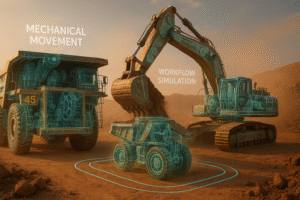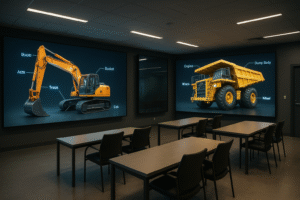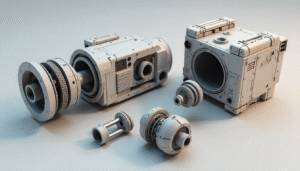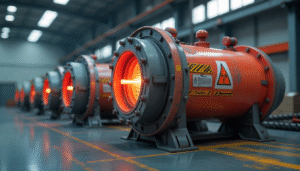Industrial automation and robotics have revolutionized manufacturing, logistics, and production industries. As automation systems become more complex, the need for precise visualization and simulation tools has grown. This is where 3D animation plays a crucial role. It helps businesses visualize robotic operations, optimize workflows, and improve training programs.
By leveraging 3D animation, companies can reduce production errors, enhance communication among teams, and streamline automation processes. From robotic simulations to interactive training programs, this technology is shaping the future of industrial automation.
This article explores how 3D animation is transforming industrial automation and robotics, detailing its benefits, applications, and prospects.
What is 3D Animation in Industrial Automation?
Definition & Overview
3D animation in industrial automation refers to the use of computer-generated imagery (CGI) to create realistic models of machines, robotic arms, and factory layouts. These animations help engineers simulate and optimize automation processes before implementation, reducing risks and improving efficiency.

Types of 3D Animation Used
- Simulation Animation: Used for testing robotic movements and automation sequences before actual deployment.
- Product Visualization: Helps manufacturers and stakeholders visualize industrial machinery and systems.
- Training Animations: Educating workers on machinery operation, maintenance, and safety procedures.
- Process Optimization Models: Visualizing industrial workflows for efficiency improvements, ensuring smooth operations.
- Virtual Prototyping: Creating digital prototypes before investing in physical development.
Benefits of Using 3D Animation in Industrial Robotics
Enhanced Visualization & Concept Communication
One of the biggest challenges in industrial automation is explaining complex robotic processes to stakeholders. 3D animation provides a clear and interactive representation of robotic workflows, making it easier for engineers, investors, and customers to understand. It eliminates ambiguity and ensures smooth collaboration.
Faster Prototyping & Design Validation
Traditional prototyping is time-consuming and expensive. 3D animation allows engineers to test different designs virtually, identifying potential flaws before manufacturing. This reduces costly errors and accelerates the development phase.
Efficient Training & Skill Development
Instead of relying on physical equipment for training, workers can engage with animated simulations, learning about automation systems without risks. This is especially beneficial in hazardous industrial environments where safety is a priority.
Real-Time Process Optimization
By integrating 3D animations with industrial data, businesses can optimize workflows and improve production efficiency. These models help identify bottlenecks, improve system integration, and streamline processes without disrupting actual operations.
Marketing & Sales Advantages
For businesses selling robotic and automation solutions, 3D animations create highly engaging product demonstrations. Potential clients can see machines in action, understand their benefits, and make informed purchase decisions.
Applications of 3D Animation in Industrial Robotics
Product Design & Engineering Simulations
3D animation is extensively used to create detailed models of robotic systems, allowing engineers to test different scenarios before real-world deployment. This enhances innovation, speeds up product development, and reduces costs.
Virtual Commissioning of Automated Systems
Instead of setting up automation systems physically, industries use virtual commissioning to test robotic functionalities in a simulated environment. This ensures seamless integration with existing workflows and reduces production downtime.
Maintenance & Troubleshooting
Interactive 3D models help technicians diagnose machine issues without physically inspecting every component. This enables faster predictive maintenance, reducing equipment failure and downtime.
Workplace Safety Training
Many industrial settings involve high-risk machinery that requires proper training. 3D animation can simulate safety procedures, allowing workers to practice emergency responses and equipment handling in a safe, virtual environment.
Marketing & Sales Presentations
Businesses use high-quality 3D animations to showcase robotic products in presentations, trade shows, and online campaigns. This helps attract investors and customers by providing a visually appealing and detailed representation of their products.

3D Animation Software Used in Industrial Automation
Some of the most widely used 3D animation tools in industrial automation include:
- Blender: Open-source and widely used for 3D modeling and animation.
- SolidWorks: Excellent for engineering and industrial design simulations.
- Autodesk Maya: Provides high-quality visualizations for robotics and manufacturing.
- Siemens Tecnomatix: Specialized in manufacturing and industrial automation modeling.
- Unity & Unreal Engine: Used for interactive and immersive AR/VR training simulations.
Each software has unique features tailored for different aspects of automation and robotics, ranging from engineering simulations to interactive 3D visualizations.
The Future of 3D Animation in Industrial Automation
AI & Machine Learning Integration
The integration of artificial intelligence (AI) with 3D animation is set to enhance robotic simulations, allowing for predictive analytics and self-optimizing automation systems. AI-powered animations will help industries predict errors, optimize production lines, and make real-time adjustments.
Augmented Reality (AR) & Virtual Reality (VR) in Industrial Simulations
AR and VR are transforming industrial training by creating immersive learning experiences. Workers can use VR headsets to interact with simulated robotic systems, enhancing their understanding without physical risks.
Increased Automation in 3D Animation Creation
New tools and software will automate 3D animation generation, making it faster and more cost-effective. This will allow even small businesses to leverage 3D animation for their automation projects.
Conclusion
3D animation is a game-changer in industrial automation and robotics. From improving design processes to enhancing training and marketing, its applications are vast. As AI, VR, and automation technologies advance, the role of 3D animation will continue to grow, making industrial operations more efficient and cost-effective.
Call-to-Action
- Want to integrate 3D animation into your automation processes? Contact industry experts for a consultation today!
- Explore the best 3D animation software for your industrial needs and start optimizing your workflows.
- Stay ahead in the robotics industry—subscribe to our newsletter for the latest automation trends.
FAQs
1. How does 3D animation help in industrial automation?
3D animation allows engineers to visualize, simulate, and optimize robotic systems before implementation, reducing costs and improving efficiency.
2. What industries benefit the most from 3D animation in robotics?
Industries such as manufacturing, automotive, aerospace, logistics, and healthcare heavily rely on 3D animation for process visualization and automation.
3. Can 3D animation reduce manufacturing costs?
Yes, by identifying potential design flaws early and optimizing processes before deployment, 3D animation significantly cuts manufacturing expenses and project lead times.
4. What are the best 3D animation tools for industrial use?
Some of the best tools include Blender, SolidWorks, Autodesk Maya, and Siemens Tecnomatix, each offering specialized features for industrial applications.
5. How will 3D animation evolve in industrial robotics?
With advancements in AI, VR, and automation, 3D animation will become more interactive and predictive, leading to smarter and more efficient industrial automation systems.






